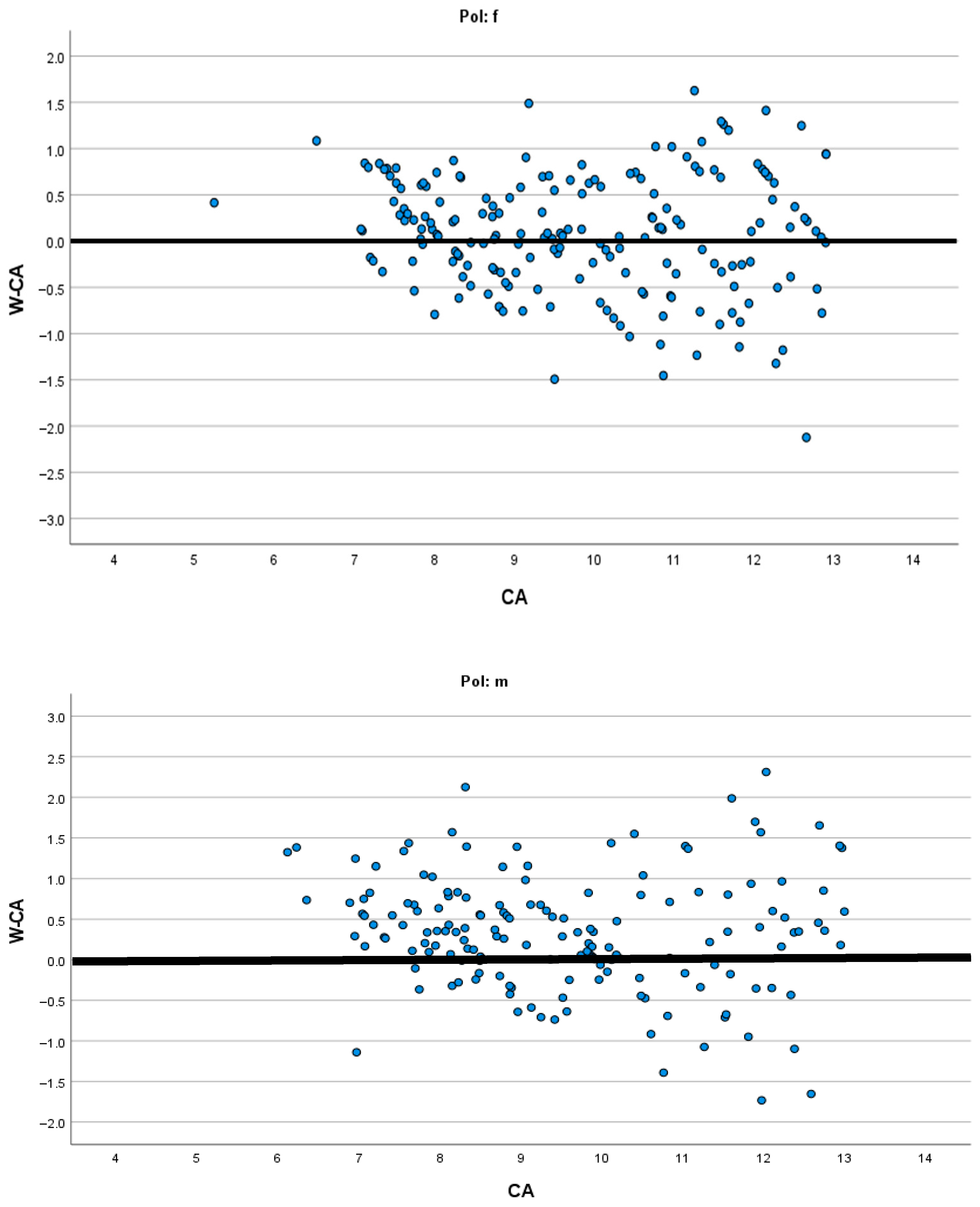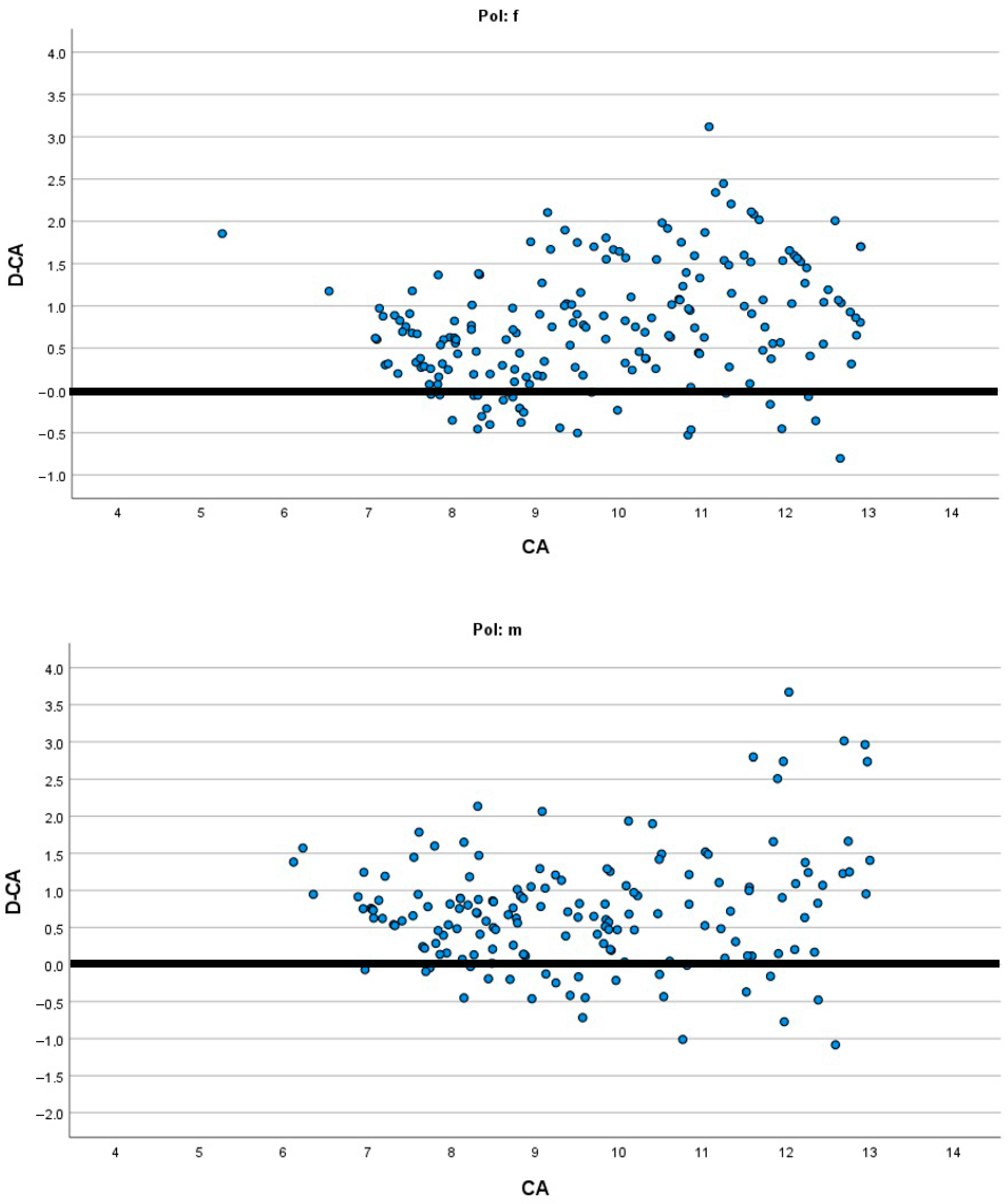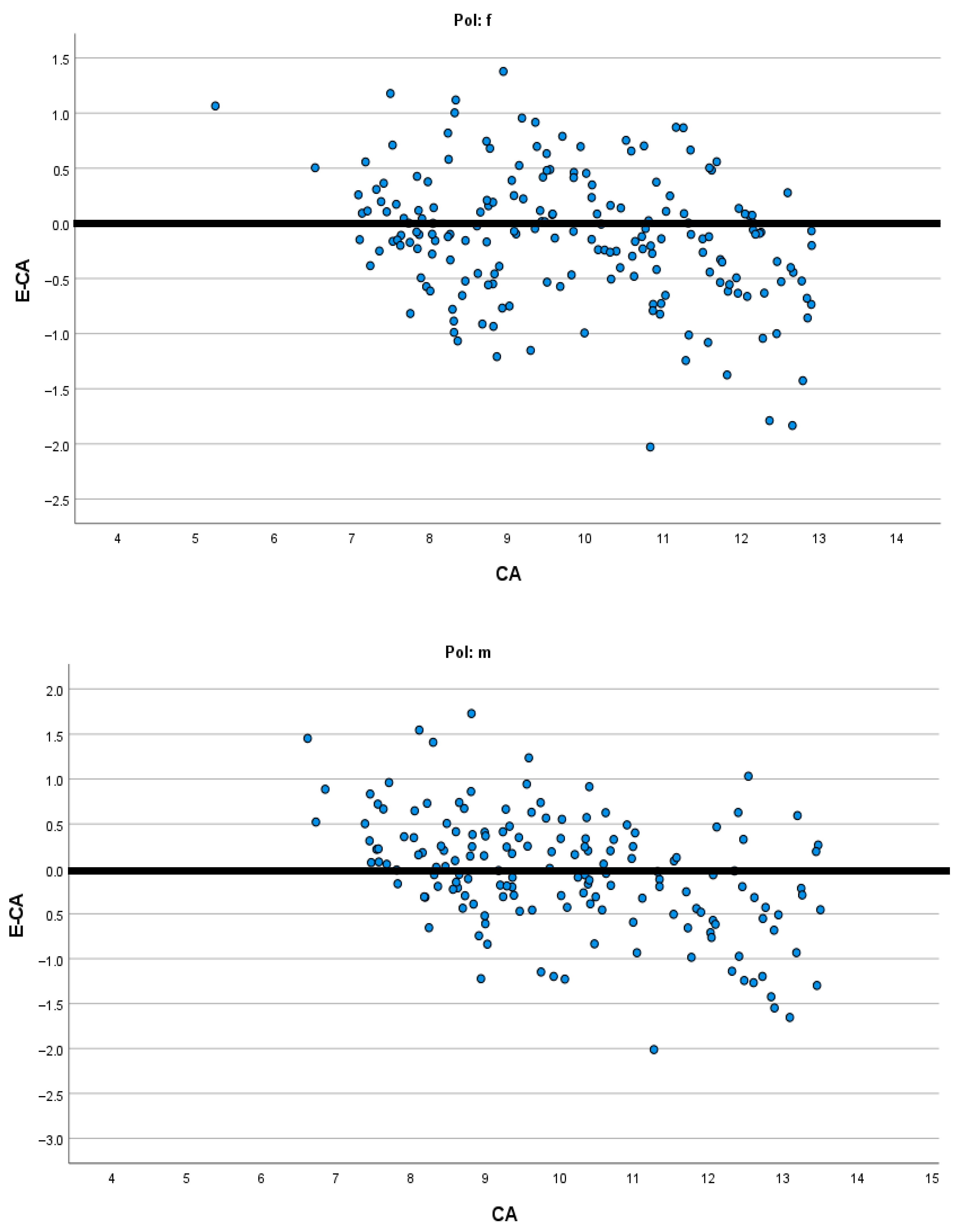An Evaluation of Four Radiological Methods for Dental Age Estimation in the Montenegrin Population
Abstract
1. Introduction
2. Materials and Methods
3. Results
4. Discussion
5. Conclusions
Author Contributions
Funding
Institutional Review Board Statement
Informed Consent Statement
Data Availability Statement
Acknowledgments
Conflicts of Interest
References
- Alrashidi, M.; Al-Moshiqah, A.; Kolarkodi, S.H.; Alotaiby, F. A Comparative Study of the Assessment of the Accuracy of Willems’ and Demirjian’s Methods in Dental Age Estimation of the Saudi Arabian Population. Cureus 2023, 15, e50128. [Google Scholar] [CrossRef] [PubMed]
- Khorate, M.M.; Dinkar, A.D.; Ahmed, J. Accuracy of age estimation methods from orthopantomograph in forensic odontology: A comparative study. Forensic Sci. Int. 2014, 234, 184.e1–184.e8. [Google Scholar] [CrossRef]
- Flood, S.J.; Franklin, D.; Turlach, B.A.; McGeachie, J. A comparison of Demirjian’s four dental development methods for forensic age estimation in South Australian sub-adults. J. Forensic Leg. Med. 2013, 20, 875–883. [Google Scholar] [CrossRef] [PubMed]
- Feijóo, G.; Barbería, E.; De Nova, J.; Prieto, J.L. Dental age estimation in Spanish children. Forensic Sci. Int. 2012, 22, e1–e5. [Google Scholar] [CrossRef]
- Celik, S.; Zeren, C.; Çelikel, A.; Yengil, E.; Altan, A. Applicability of the Demirjian method for dental assessment of southern Turkish children. J. Forensic Leg. Med. 2014, 25, 1–5. [Google Scholar] [CrossRef]
- Altan, H.; Altan, A.; Sozer, O.A. Dental age estimation in southern Turkish children: Comparison of Demirjian and Willems methods. Inn. J. Pediatr. 2017, 27, e11726. [Google Scholar] [CrossRef]
- Willems, G.; Van Olmen, A.; Spiessens, B.; Carels, C. Dental age estimation in Belgian children: Demirjian’s technique revisited. J. Forensic Sci. 2001, 46, 893–895. [Google Scholar] [CrossRef]
- Esan, T.A.; Yengopal, V.; Schepartz, L.A. The Demirjian versus the Willems method for dental age estimation in different populations: A meta-analysis of published studies. PLoS ONE 2017, 12, e0186682. [Google Scholar] [CrossRef]
- Melo, M.; Ata-Ali, F.; Ata-Ali, J.; Martinez Gonzalez, J.M.; Cobo, T. Demirjian and Cameriere methods for age estimation in a Spanish sample of 1386 living subjects. Sci. Rep. 2022, 12, 2838. [Google Scholar] [CrossRef]
- Hostiuc, S.; Diaconescu, I.; Rusu, M.C.; Negoi, I. Age Estimation Using the Cameriere Methods of Open Apices: A Meta-Analysis. Healthcare 2021, 9, 237. [Google Scholar] [CrossRef]
- Marinkovic, N.; Milovanovic, P.; Djuric, M.; Nedeljkovic, N.; Zelic, K. Dental maturity assessment in Serbian population: A comparison of Cameriere’s European formula and Willems’ method. Forensic Sci. Int. 2018, 288, 331.e1–331.e5. [Google Scholar] [CrossRef] [PubMed]
- Kvaal, S.I.; Kolltveit, K.M.; Thomsen, I.O.; Solheim, T. Age estimation of adults from dental radiographs. Forensic Sci. Int. 1995, 74, 175–185. [Google Scholar] [CrossRef]
- Zelic, K.; Marinkovic, N.; Milovanovic, P.; Cameriere, R.; Djuric, M.; Nedeljkovic, N. Age estimation in children based on open apices measurement in the Serbian population: Belgrade Age Formula (BAF). Ann. Hum. Biol. 2020, 47, 229–236. [Google Scholar] [CrossRef] [PubMed]
- Marković, J.; Marinković, N.; Arsić, I.; Zelić, K.; Stamenković, Z.; Glamočanin, B.; Nedeljković, N. The accuracy of Belgrade Age Formula method for dental age estimation in Montenegrin children aged 10–12 years. Srp. Arh. Celok. Lek. 2022, 150, 643–647. [Google Scholar] [CrossRef]
- Demirjian, A.; Goldstein, H.; Tanner, J.M. A new system of dental age assessment. Hum. Biol. 1973, 45, 211–227. [Google Scholar]
- Cameriere, R.; Ferrante, L.; Cingolani, M. Age estimation in children by measurement of open apices in teeth. Int. J. Leg. Med. 2006, 120, 49–52. [Google Scholar] [CrossRef]
- Krouwer, J.S. Why Bland-Altman plots should use X, not (Y+X)/2 when X is a reference method. Stat. Med. 2008, 27, 778–780. [Google Scholar] [CrossRef] [PubMed]
- Faul, F.; Erdfelder, E.; Lang, A.-G.; Buchner, A. G*Power 3: A flexible statistical power analysis program for the social, behavioral, and biomedical sciences. Behav. Res. Methods 2007, 39, 175–191. [Google Scholar] [CrossRef]
- Liversidge, H.M.; Buckberry, J.; Marquez-Grant, N. Age estimation. Ann. Hum. Biol. 2015, 42, 299–301. [Google Scholar] [CrossRef]
- Milani, S.; Benso, L. Why we can’t determine reliably the age of a subject on the basis of his maturation degree. J. Forensic Leg. Med. 2019, 61, 97–101. [Google Scholar] [CrossRef]
- Cameron, N. Can maturity indicators be used to estimate chronological age in children? Ann. Hum. Biol. 2015, 42, 302–307. [Google Scholar] [CrossRef]
- Levinson, A. Unaccompanied Immigrant Children: A Growing Phenomenon with Few Easy Solutions [Internet]. 2011. Available online: https://www.migrationpolicy.org/article/unaccompanied-immigrant-children-growing-phenomenon-few-easy-solutions (accessed on 24 April 2025).
- Crawley, H. When Is a Child Not a Child? Asylum, Age Disputes and the Process of Age Assessment. 2000. Available online: https://www.academia.edu/25307504/When_is_a_Child_not_a_Child_Asylum_Age_Disputes_and_the_Process_of_Age_Assessment (accessed on 24 April 2025).
- Flood, S.J.; Mitchell, W.J.; Oxnard, C.E.; Turlach, B.A.; McGeachie, J. A comparison of Demirjian’s four dental development methods for forensic age assessment. J. Forensic Sci. 2011, 56, 1610–1615. [Google Scholar] [CrossRef] [PubMed]
- Bedek, I.; Dumančić, J.; Lauc, T.; Marušić, M.; Čuković-Bagić, I. Applicability of the Demirjian, Willems and Haavikko methods in Croatian children. J. Forensic Odontostomatol. 2022, 40, 21–30. [Google Scholar] [PubMed] [PubMed Central]
- Sezer, B.; Çarıkçıoğlu, B. Accuracy of the London Atlas, Haavikko’s Method and Cameriere’s European Formula of dental age estimation in Turkish children. Leg. Med. 2022, 54, 101991. [Google Scholar] [CrossRef] [PubMed]
- Yang, Z.; Wen, D.; Xiao, J.; Liu, Q.; Sun, S.; Kureshi, A.; Chang, Y.; Zha, L. Application of Cameriere’s method for dental age estimation in children in South China. Forensic Sci. Res. 2021, 7, 106–114. [Google Scholar] [CrossRef] [PubMed]
- Halilah, T.; Khdairi, N.; Jost-Brinkmann, P.G.; Bartzela, T. Age estimation in 5-16-year-old children by measurement of open apices: North German formula. Forensic Sci. Int. 2018, 293, 103.e1–103.e8. [Google Scholar] [CrossRef]
- Brkić, H.; Galić, I.; Vodanović, M.; Dumančić, J.; Mehdi, F.; Anić Milošević, S. The Cameriere, Haavikko, Demirjian, and Willems methods for the assessment of dental age in Croatian children. Int. J. Legal Med. 2022, 136, 1685–1696. [Google Scholar] [CrossRef]
- Dervišević, E.; Selmanagić, A.; Milovanović, P.; Zelić-Mihajlović, K. Age Determination Based on Open Apex Measurement in the Developing Dentition: Comparing the Accuracy of the Belgrade Age Formula (BAF) with the European Formula on a Bosnian Children Population. Acta Stomatol. Croat. 2024, 58, 209–217. [Google Scholar] [CrossRef]
- Hostiuc, S.; Edison, S.E.; Diaconescu, I.; Negoi, I.; Isaila, O.M. Accuracy of the Demirjian’s method for assessing the age in children, from 1973 to 2020. A meta-analysis. Leg. Med. 2021, 52, 101901. [Google Scholar] [CrossRef]
- Darıcı, A.; Ölmez, M.S.; Güngör, H.C.; Rajavaara, P.; Sipola, A.; Anttonen, V.; Päkkilä, J. Comparison of accuracy of different dental age estimation methods in Finnish and Turkish populations. Acta Odontol. Scand. 2024, 22, 643–652. [Google Scholar] [CrossRef]
- Bedek, I.; Dumančić, J.; Lauc, T.; Marušić, M.; Čuković-Bagić, I. New model for dental age estimation: Willems method applied on fewer than seven mandibular teeth. Int. J. Legal Med. 2020, 134, 735–743. [Google Scholar] [CrossRef] [PubMed]
- Vila-Blanco, N.; Varas-Quintana, P.; Tomás, I.; Carreira, M.J. A systematic overview of dental methods for age assessment in living individuals: From traditional to artificial intelligence-based approaches. Int. J. Legal Med. 2023, 137, 1117–1146. [Google Scholar] [CrossRef] [PubMed]




| Age Category | Male | Female |
|---|---|---|
| 6.00–6.99 | 7 | 2 |
| 7.00–7.99 | 27 | 31 |
| 8.00–8.99 | 39 | 38 |
| 9.00–9.99 | 30 | 31 |
| 10.00–10.99 | 18 | 34 |
| 11.00–11.99 | 21 | 28 |
| 12.00–12.99 | 19 | 26 |
| Estimated DA 1—CA 2 | Mean | Std. Deviation 3 | p Value |
|---|---|---|---|
| females | |||
| W 4—CA | 0.08 | 0.64 | 0.07 |
| D 5—CA | 0.77 | 0.70 | 0.00 * |
| E 6—CA | −0.12 | 0.58 | 0.00 * |
| B 7—CA | −0.10 | 0.61 | 0.02 * |
| males | |||
| W—CA | 0.33 | 0.70 | 0.00 * |
| D—CA | 0.72 | 0.77 | 0.00 * |
| E—CA | −0.04 | 0.64 | 0.39 |
| B—CA | 0.24 | 0.63 | 0.00 * |
| Age Category | CA 1 Mean 6 ± SD 7 | W 2—CA Mean ± SD | W—CA ABS 8 ± SD | D 3—CA Mean ± SD | D—CA ABS ± SD | E 4—CA Mean ± SD | E—CA ABS ± SD | BAF 5—CA Mean ± SD | BAF—CA ABS ± SD |
|---|---|---|---|---|---|---|---|---|---|
| 7–7.99 | 7.56 ± 0.31 | 0.32 ± 0.38 | 0.41 ± 0.26 | 0.51 ± 0.35 | 0.52 ± 0.34 | 0.04 ± 0.39 | 0.29 ± 0.26 | −0.26 ± 0.40 | 0.41 ± 0.26 |
| 8–8.99 | 8.49 ± 0.30 | −0.04 ± 0.45 | 0.37 ± 0.25 | 0.32 ± 0.55 | 0.48 ± 0.40 | −0.16 ± 0.64 | 0.53 ± 0.38 | −0.30 ± 0.71 | 0.65 ± 0.40 |
| 9–9.99 | 9.46 ± 0.28 | 0.11 ± 0.58 | 0.43 ± 0.40 | 0.85 ± 0.70 | 0.93 ± 0.59 | 0.12 ± 0.54 | 0.44 ± 0.33 | 0.24 ± 0.61 | 0.50 ± 0.42 |
| 10–10.99 | 10.56 ± 0.31 | −0.10 ± 0.65 | 0.53 ± 0.37 | 0.86 ± 0.62 | 0.94 ± 0.53 | −0.16 ± 0.52 | 0.42 ± 0.37 | −0.01 ± 0.45 | 0.37 ± 0.26 |
| 11–11.99 | 11.52 ± 0.28 | 0.08 ± 0.82 | 0.70 ± 0.43 | 1.18 ± 0.90 | 1.22 ± 0.83 | −0.19 ± 0.61 | 0.52 ± 0.36 | −0.02 ± 0.65 | 0.53 ± 0.37 |
| 12–12.99 | 12.47 ± 0.30 | 0.15 ± 0.84 | 0.68 ± 0.50 | 1.01 ± 0.69 | 1.10 ± 0.51 | −0.50 ± 0.56 | 0.54 ± 0.53 | −0.30 ± 0.61 | 0.51 ± 0.44 |
| Age Category | CA 1 Mean 6 ± SD 7 | W 2—CA Mean ± SD | W—CA ABS 8 ± SD | D 3—CA Mean ± SD | D—CA ABS ± SD | E 4—CA Mean ± SD | E—CA ABS ± SD | BAF 5—CA Mean ± SD | BAF—CA ABS ± SD |
|---|---|---|---|---|---|---|---|---|---|
| 7–7.99 | 7.55 ± 0.38 | 0.53 ± 0.43 | 0.56 ± 0.38 | 0.65 ± 0.46 | 0.66 ± 0.44 | 0.28 ± 0.50 | 0.41 ± 0.40 | 0.26 ± 0.60 | 0.48 ± 0.44 |
| 8–8.99 | 8.48 ± 0.28 | 0.37 ± 0.59 | 0.52 ± 0.47 | 0.57 ± 0.55 | 0.64 ± 0.46 | 0.02 ± 0.54 | 0.41 ± 0.34 | 0.31 ± 0.58 | 0.49 ± 0.42 |
| 9–9.99 | 9.57 ± 0.31 | 0.15 ± 0.49 | 0.39 ± 0.31 | 0.52 ± 0.62 | 0.67 ± 0.44 | 0.03 ± 0.63 | 0.50 ± 0.37 | 0.37 ± 0.63 | 0.58 ± 0.45 |
| 10–10.99 | 10.42 ± 0.27 | 0.11 ± 0.78 | 0.59 ± 0.51 | 0.67 ± 0.80 | 0.85 ± 0.60 | −0.13 ± 0.61 | 0.41 ± 0.47 | 0.32 ± 0.53 | 0.49 ± 0.36 |
| 11–11.99 | 11.53 ± 0.32 | 0.25 ± 1.01 | 0.85 ± 0.59 | 0.85 ± 0.99 | 0.98 ± 0.86 | −0.38 ± 0.52 | 0.54 ± 0.35 | 0.06 ± 0.58 | 0.43 ± 0.38 |
| 12–12.99 | 12.51 ± 0.32 | 0.45 ± 0.93 | 0.82 ± 0.60 | 1.26 ± 1.19 | 1.42 ± 0.98 | −0.56 ± 0.74 | 0.78 ± 0.49 | −0.10 ± 0.86 | 0.67 ± 0.51 |
| Dental Age Estimation Methods | Sex | Underestimation/Overestimation of Dental Age | |
|---|---|---|---|
| ±6 Months * | ±12 Months ** | ||
| Willems | Females | 52.1% | 89.5% |
| Males | 50.3% | 80.1% | |
| Demirjian | Females | 35.8% | 65.3% |
| Males | 35.4% | 70.2% | |
| European formula | Females | 61.0% | 91.1% |
| Males | 60.9% | 88.2% | |
| BAF | Females | 57.9% | 87.4% |
| Males | 57.1% | 86.3% | |
Disclaimer/Publisher’s Note: The statements, opinions and data contained in all publications are solely those of the individual author(s) and contributor(s) and not of MDPI and/or the editor(s). MDPI and/or the editor(s) disclaim responsibility for any injury to people or property resulting from any ideas, methods, instructions or products referred to in the content. |
© 2025 by the authors. Licensee MDPI, Basel, Switzerland. This article is an open access article distributed under the terms and conditions of the Creative Commons Attribution (CC BY) license (https://creativecommons.org/licenses/by/4.0/).
Share and Cite
Pajevic, T.; Marinkovic, N.; Arsic, I.; Markovic, J.; Milovanovic, P.; Stamenkovic, Z.; Nedeljkovic, N. An Evaluation of Four Radiological Methods for Dental Age Estimation in the Montenegrin Population. Diagnostics 2025, 15, 1769. https://doi.org/10.3390/diagnostics15141769
Pajevic T, Marinkovic N, Arsic I, Markovic J, Milovanovic P, Stamenkovic Z, Nedeljkovic N. An Evaluation of Four Radiological Methods for Dental Age Estimation in the Montenegrin Population. Diagnostics. 2025; 15(14):1769. https://doi.org/10.3390/diagnostics15141769
Chicago/Turabian StylePajevic, Tina, Nemanja Marinkovic, Ivan Arsic, Jovan Markovic, Petar Milovanovic, Zorana Stamenkovic, and Nenad Nedeljkovic. 2025. "An Evaluation of Four Radiological Methods for Dental Age Estimation in the Montenegrin Population" Diagnostics 15, no. 14: 1769. https://doi.org/10.3390/diagnostics15141769
APA StylePajevic, T., Marinkovic, N., Arsic, I., Markovic, J., Milovanovic, P., Stamenkovic, Z., & Nedeljkovic, N. (2025). An Evaluation of Four Radiological Methods for Dental Age Estimation in the Montenegrin Population. Diagnostics, 15(14), 1769. https://doi.org/10.3390/diagnostics15141769







